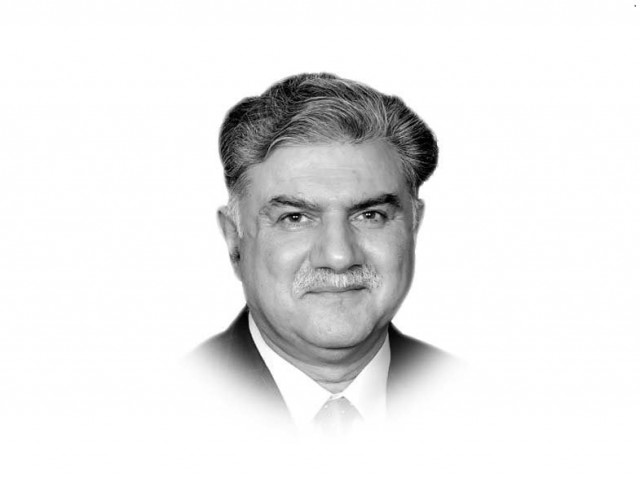The Afghan civil war — is Pakistan at the crossroads?
Islamabad frets over the estimated 6,500 TTP fighters, joining hands with the Afghan Taliban

The anti-Taliban forces are in overdrive in one ominous prediction after another about the looming civil war in Afghanistan, mainly because of the obduracy of the medieval savages, aka the Taliban, as if dithering on the Doha Accord was okay for Ashraf Ghani. And the liberal brigade is at the forefront, in a sullen fall from grace at the hands of these very ragtags.
Pakistan flip-flops quite uncharacteristically. On July 1, 2021, the Parliamentary Committee on National Security had a marathon in-camera session, attended by the COAS and DGISI to brief the committee. Press coverage reveals some interesting positions.
While desisting from being seen ‘overtly pro-China’, the presenters emphasised balanced relations with US and China and working on a relationship with America, ostensibly after the PM’s tough line on US basing/partnership in war etc. In response to a sly question, Shahbaz Sharif was apprised that the “PM had refused” to re-provide Shamsi, distancing the establishment. There are indications of strategic reorientation of our foreign policy, that has implications for CPEC and Sino-Pakistan relations.
On Afghanistan, the meeting was informed of Pakistan not supporting the Taliban “forming an emirate” as the 1990s, and that “the 18th century mindset is unacceptable.” That the extended troika (Pakistan, US, Russia and China) does not support a Taliban military takeover. And that Pakistan’s major strategic interest remains preventing Afghan territory from being used against Pakistan. This obviously is a fraction of our strategic interest(s).
That Islamabad frets over the estimated 6,500 Tehreek-i-Taliban Pakistan (TTP) fighters, joining hands with the Afghan Taliban, if Kabul falls. That this eventuality would embolden other violent extremist groups in Pakistan. That the TTP and the Afghan Taliban are “two sides of the same coin”. With dwindling influence on the Afghan Taliban, Pakistan expects around 700,000 new refugees, if the situation escalates.
These are interesting iterations. First, re-pivoting to the US/West is the cherished goal of our sold-out ashhrafiyya (elite), tasked to keep Pakistan in the West’s exploitative orbit, by scaring its leaders and creating hurdles for projects like CPEC and friends like China. Their penetration is deep and significant. Imran Khan might be a lone voyager. CPEC, one firmly believes, is Pakistan’s only chance to break away from the US/western dependency. America, as a declining superpower is likely to be second fiddle to China in a not-too-distant future, making pivoting to its side, a poor choice.
Second, the US did not sign the Doha accords (ignoring the puppet and puppeteer, Ashraf Ghani et al) out of love for the ragtag. It was a sheer compulsion. For Biden’s America, Afghanistan is a far away and insignificant foreign policy priority, a bottomless pit; unnecessarily distracting US policy from containing an unstoppable Middle Kingdom and a resurgent Russia; besides, domestically, addressing the worsening race-relations, crumbling infrastructure, faltering education system, Covid-induced poverty and economic stagnation etc.
The US, in tossing the proverbial Afghan “blanket”, and hastening to exits is calling Ashraf Ghani’s bluff leaving him no choice but to sit with a more conciliatory Taliban, that America considers more important. Why would it otherwise cut a deal with an enemy, it fought for 20 long years? The world gets it, only we seem to not get it.
Third, the “18th century savages” are not replicating their 1996 version. Then, in a spontaneous reaction against lawlessness, corruption and lack of governance; the seminary students burst on the national scene routing the warlords. Then they were inexperienced in combat, governance, administration and media handling. Their 2021 version is experienced in running a credible shadow government for two decades under the nose of the US/NATO and Afghan government, providing security, administration and other services in all provinces, following a proper chain of command. They are media-savvy and very sensitive to their erstwhile unpopular legacy.
And Taliban.21 are following an effective strategy. Nibbling spaces, dominating the night, ruling the countryside so effectively that even the US/NATO had been paying rahdari (toll) for their military movements; occupying areas surrounding major cities; emphasising on the peaceful surrender (tasleem) invoking Afghan brotherhood, and issuing reassuring broadcasts to allay fears and rumours are clever deeds.
Taliban.21 are experienced in diplomacy, negotiations and realpolitik. Their year-long Doha parleys establish their credentials in dealing with a superpower, better than many states. They remain exposed to modern influences like education, foreign habitation and media in all forms. Realising the power of unofficial media, their footage regarding surrendered ANA troops, is poles apart from their 1996 model.
Fourth, militarily, they are getting boots on ground in the non-Pashtun highland (mainly north), sealing important borders. This suppresses potential challenges to their rule, stopping Central Asian support for such challengers. Pashtun east and south are theirs to take, as recent surrender of a Kandahar district validates. This is not the work of the run of the mill, the uncouth and the unschooled. Today, the Taliban occupy more areas than they did in the 1990s and follow a defined and efficacious chain of command, keeping well-informed of popular pulse, strategic dynamics and ground situation.
So, who will fight them in the feared civil war? The warlords with no moral authority (if not foreign-supported), the politicians already in secret parleys with the Taliban, the dispirited ANA troops surrendering/fleeing in droves, the urban vigilantes and/or the general public? People lived under their shadow government all these years, despite the almost 50 nations keeping over 150,000 troops on Afghan soil. We do not seem to get it.
Yes, there would be panic flights, desertions and localised violence. Those desperate to flee are either complicit in crimes against the Taliban, or gullible and scared individuals, or opportunists fleeing for greener pastures.
So, what to expect? With the north pacified through military presence, a tasleem strategy delivers rural hinterland to the Taliban. The restarted Doha parleys might lead to an outline political settlement. Pockets of defiance (if any), would resist till foreign patronage runs out (the Taliban purposefully captured Tajikistan crossing). And the Taliban patiently wait-out the fall of besieged cities, especially Kabul.
The Taliban would remain a US/West-reliant given the crucial US assistance ($4 billion yearly upto 2024) and other aid under the Doha agreement. However, any dithering by the US would deliver Afghanistan to an eagerly waiting China, under the Belt and Road Initiative. A sullen India would reluctantly reach out to the Taliban, ditching Ghani (like Dr Najeebullah).
Lastly, the Taliban rule may be the only chance for regional/neighbourhood stability. Pakistan and the US knew it back in 1996. So, why is our ashhrafiyya so afraid of sharia/Islam in our neighbourhood? China gets it, the Taliban get it, we do not.
Published in The Express Tribune, July 8th, 2021.
Like Opinion & Editorial on Facebook, follow @ETOpEd on Twitter to receive all updates on all our daily pieces.
















COMMENTS
Comments are moderated and generally will be posted if they are on-topic and not abusive.
For more information, please see our Comments FAQ